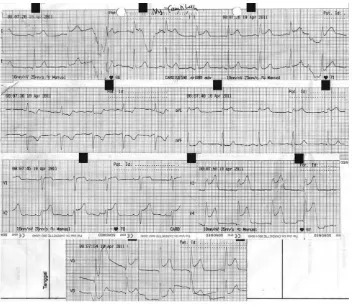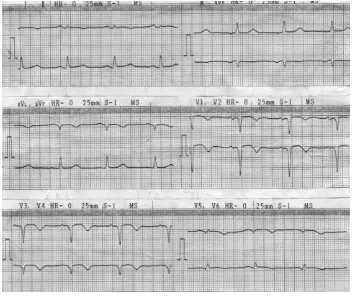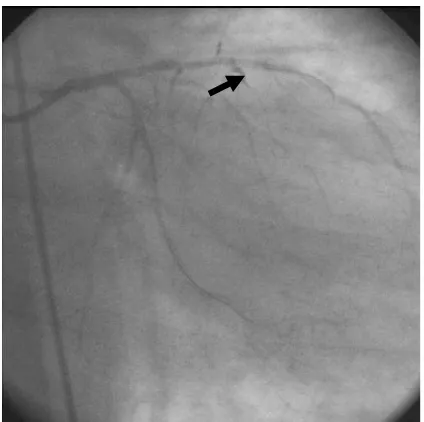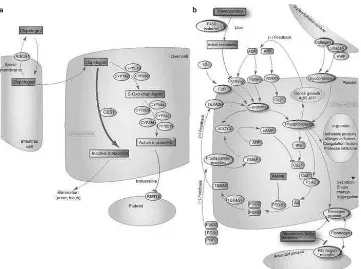Clopidogrel Resistance in Patients with Coronary Stent Thrombosis
Dyah Wulan Anggrahini, Bambang Irawan, Lucia Kris Dinarti
Department of Cardiology and Vascular Medicine, Faculty of Medicine, Universitas Gadjah Mada / Sardjito General Hospital Yogyakarta
Abstract
Antiplatelet drugs plays important role in the therapy of atherothrombosis. Dual antiplatelet therapy is recommended as a strategy for the prevention of stent thrombosis in patients who underwent Percutaneus Coronary Intervention (PCI). In combination with aspirin, tienoperidine is currently the drug of choice to prevent stent thrombosis. The issue of the high inter-individual variability of response is clinically relevant, since poor responders are not adequately protected from major adverse cardiac events (MACE). We reported a 62-years old woman underwent primary PCI with implantation of BAS. She was later known to have in-stent thrombosis in the LAD after repeated angiography. The probable cause for the later cardiac event in this patient were overlapped stent, small vessel diameter, diabetes mellitus, and the patients also shown a persistent platelet reactivity despite clopidogrel therapy. We administered this patient with pasugrel as antiplatelet replacing clopidogrel and the patient was managed without ischemic symptoms afterwards.
Introduction
Antiplatelet drugs plays important role in the therapy of atherothrombosis. Dual antiplatelet therapy is recommended as a strategy for the prevention of stent thrombosis in patients who underwent Percutaneus Coronary Intervention (PCI). In combination with aspirin, tienoperidin is currently the drug of choice to prevent stent thrombosis. Stent thrombosis remains an important and potentially lethal clinical problem (incidence-0.9%, mortality-8.9%). To date, clopidogrel, a second generation of tienoperidin has replaced ticlopidin due to its tolerability evidenced in CLASSIC trial – Clopidogrel Aspirin International Cooperative (Bertrand et al., 2000; Campo et al., 2010).
Clopidrogel P2Y12 has a very selective tissue distribution, making it an attractive molecular target for therapeutic intervention. Indeed, P2Y12 is the target of effi cacious antithrombotic agents. It is a pro-drug that need to be converted in vivo to active metabolites by the hepatic cytochrome P-450 (CYP). Their active metabolite then binds to P2Y12, forming a disulfi de bond with a cysteine residue of the receptor, thereby irreversibly inhibiting it (Cattaneo and Podda, 2010). Despite its proven antithrombotic effi cacy, clopidogrel lacks some important features of the ideal antithrombotic agent The issue of the high inter-individual variability of response is clinically relevant, since poor responders are not adequately protected from major adverse cardiac events
(MACE). Several studies show that about one-third of treated patients do not display adequate inhibition of P2Y12-dependent platelet function (‘‘clopidogrel resistance’’). This is associated with loss of function mutations of CYP isoform, and with interference with common adjunctive medications, such as proton pump inhibitors (PPI) and other conditions (Cattaneo and Podda, 2010) .
Despite the unambiguous clinical benefi t achieved with the adjunct of clopidogrel in ACS/ PCI patients, a considerable number of patients continue to have cardiovascular events. This has been, in part, attributed to the fact than some patients may have poor clopidogrel-induced antiplatelet effects. These patients, in fact, despite treatment with clopidogrel, persist with enhanced platelet reactivity, which is pivotal for the development of atherothrombotic complications (Angiolillo et al., 2007; Wiviott, 2006). Several mechanism were proposed for the individual variability response to clopidogrel including metabolic activity CYP450 which are interaction to other drugs or the presence of genetic polymorphism in coding gen CYP450, as well as the cellular factor, i.e, platelet reactivity, clinical condition, drug compliance and underlying risk factors (Gurbel and Tantry, 2011).
Case
We reported a 62-years old female who came to the emergency department of RSUP dr. Sardjito. She was having infarction type chest pain 4.5 hours prior to the admission. The risk
[image:2.595.125.477.84.392.2]factors of this patient were hypertension, poorly controlled diabetes mellitus, dyslipidemia and obesity. On arrival, the physical examination revealed that her blood pressure was 110/70 mmHg, pulse 70x/minutes, respiration rate was respirasi 20x/minutes. We did not find Figure 1. ECG tracing of the patient in the emergency unit with infarction type
angina. The picture showed an ST segmen elevation in anterior extensive area (I, aVL, V1-V6 ).
Figure 2. First coronary angiography at the time of STEMI before Primary PCI. (A). Totally occluded vessel at mid LAD as culprit lesion (B). Reperfused LAD after BAS implantation
[image:2.595.104.502.441.637.2]any signs and symptoms for heart failure. The electrocardiography examination showed sinus rhythm, with the heart rate 70x/minutes, and there was an ST segmen elevation on the I, aVL, V1-V6 leads with the reciprocal ST segmen depression in di II, aVF (fi gure 1). There was no abnormlity in the head and neck examination. The cardiac physical examination revealed an enlargement of the heart, without changing in the 1st and 2nd heart
sound. We could not fi nd any gallop nor murmur. Lung examination was clear and the abdominal condition was normal.
Laboratory examinations showed creatinine kinase (CK) 91U/L; creatinin kinase MB (CKMB) 23 U/L; Troponin-I 0.06 ug/L; total cholesterol 199 mg/ dl; high density lipoprotein (HDL) 37.3 mg/dl; low density lipoprotein (LDL) 146 mg/dl; trygliseride 44 mg/dl; dan random blood glucose 440 mg/dl.
Based on the data above we diagnosed this patient as having anterior extensive ST-elevation myocardial infarction/STEMI onset 4.5 jam Killip I. The patient received aspirin 320 mg and clopidrogel 300 mg and proceed for primary PCI. Coronary angiography revealed a total occlusion in the mid Left Anterior Descenden (LAD) that was thought as a culprit lesion, a normal Left Main
(LM), a normal Left Circumfl ex (LCx) and Right Coronary Artery (RCA).
We further performed coronary intervention in this patient with balloon predilatation size 2.0/15 mm 10-16 atm and the bio-active stent (TITAN®) implantation n sized 2.75/19 mm overlapped with size 2.5/16 mm in the culprit lesion, with nitrogliserin infusion 2.5 ug/minutes as well as 6000 unit heparin intraveously. At the end we showed improvement in the coronary fl ow with TIMI score 3 without any residual lesion (Figure 2). Eptifibatide infusion 2 ug/kg/minutes were administered after the stent implantation.
Patient was then hospitalized in ICCU for 5 days with medical treatments consisting aspirin 160mg/day, clopidogrel 75 mg/12 hour, captopril 6.25 mg/8 hour, isosorbid dinitrate (ISDN) 5 mg/8 hour, atorvastatin 40 mg/24 hour, basal insulin 20 unit-0-0 dan mixture 8-8-8, bisoprolol 1.25 mg/24 hour. During hospitalization, there was an event of stable ventricular tachycardia that was maintained using amiodaron bolus 150 mg followed by 1 mg/minute, 0.5 mg/minute, and orally 200 mg/8 hour.
[image:3.595.118.470.85.382.2]One month later, patient was complaining of reccurent angina on effort, but there was no Figure 3. ECG record revealed an old myocardial infarction (I, avL, dan
ECG change on the outpatient examination. The diagnosis was Stable Angina Pectoris CCS II. We continued the dual antiplatelet therapy using aspirin 80mg dan clopidogrel 75 mg daily. Three months after the infarction, the patient was having another episode of recurrent angina which was frequent and increased in intensity and clinically diagnosed as unstable angina pectoris. The vital sign was stable with BP 110/70 mmHg, pulse 70x/minute, and respiratory rate 18x/minute. The ECG examination showed sinus rhythm with old miocardial infarction (Figure 3). There was no
increase in cardiac marker with the levels of CK 46U/L, CKMB 15U/L, and Troponin-I <0.01. The lady was then admitted in ICCU as suspected stent thrombosis. During hospitalization, she frequently complained of having resting angina without any changes in ECG tracing, thus another coronary angiography was then performed.
On coronary angiography evaluation, we found a totally occluded in mid LAD which was previously implanted by BAS. In addition, there was an 80% stenosis in LCx (Figure 4). Another intervention was then performed in LAD using
[image:4.595.98.497.85.282.2]A B
Figure 4. Second coronary angiography as compared to the fi rst one at the time of primary PCI A. In stent occlusion on second angiography B. totally occluded LAD at fi rst angiography at the time of primary PCI
[image:4.595.177.389.334.545.2]staged balloning with coronary balloon sized 1.5/20 mm and 2.5/20 mm and using 14 atm pressures. Due to some diffi culties in the procedure, nitroglycerin 200 ug and eptifi batide was administered before balloon infl ation. For the LCx lesion, we performed balloon dilatation using 2.5/20 mm on 10 atm and the implantation of bare metal stent (BMS) sized 2.75/20 mm. The fi nal result was 30% residual stenosis in LAD (fi gure 5).
The patients was considered of having an antiplatelet resistance that may cause the in stent thrombosis. Therefore we performed a platelet aggregation test for aspirin and clopidogrel using light transmission agregometer method (Verify-Now, San Diego, California) untuk melihat efek aspirin dan clopidogrel. The results showed a good inhibition of platelet aggregation by aspirin (ARU 419; normal <550) and a minimal response by clopidogrel (Inhibitory effect by 13% from normal range 40-60%). The plateler reactivity showed remaining high level with PRU 298 from base 341; normal <230. Based on the result, the patient was categorized as a non responder to clopidogrel or having clopidogrel resistance.
The patient was then discharged from the hospital after we administered new antiplatelet to replace clopidogrel. The agent given to her was pasugrel 10 mg/hari. There was no complaint after the new medication.
Discussion
Thrombosis and restenosis in coronary stent could manifest as a recurrent angina. According to the American Research Concorcium, stent thrombosis was classifi ed based on time which are early stent thrombosis ( 0-1 month), late stent thrombosis (1 month – 1 year), and very late stent thrombosis (>1 year). The defi nite diagnosis is based on the coronary angiography that revealed a thrombus in the previous stent or 5 mm proximal or distal to the previous stent. (Lemesle et al., 2008). In stent restenosis (ISR) is a restenosis in the previous stent with the degree of stenosis >50%. ISR was classifi ed as focal when the lesion <10mm or diffuse when the lesion >10 mm (Mitra and Agrawal, 2006). On the case above, the recurrent and progressif angina 2 month post BAS implantation and supported by the evaluation of coronary angiography revealing a total occlusion in the previous stent showed a late stent trombosis with differential diagnosis as an in-stent restenosis.
Several predictor for stent thrombosis are stent implantation in the small diameter vessel, multiple lesion, stent implantation in the long stenotic lesion, overlapped stenting, a bifurcation lesion, an apposition or suboptimal stent implantation, low EF, DM, renal impairement, acute coronary syndrome, and interruption in the antiplatelet administration including premature cessation and the drug compliance (Wijns et al., 2010). The predictor in this patient were small vessel, overlapped stent, DM, and STEMI.
To prevent ST or ISR, a normal response to platelet aggregation should be inhibited. Several drugs has been approved for this purpose, i.e. aspirin, tienoperidine, as well as glycoprotein IIb/ IIIa inhibitor (Gurbel et al., 2003). Several clinical trials showed that clopidogrel was better tolerated than ticlopidine and was associated with lower side effect. The optimal dose for clopidogrel to inhibit platelet aggregation post PCI procedure is 300 – 600 mg as a loading dose continued by 75 mg daily (Vats et al., 2006). The use of clopidogrel as recommended dual antiplatelet with aspirin has been showed in the CREDO trials, to reduce cardiovascular event post PCI as 38.6% consisting of death, myocardial infarction, and repeat revascularization after 4 weeks of treatment. (Eriksson, 2004). Guidelines showed that for patients with STEMI, NSTEMI, and for those who underwent PCI recommends the dual antiplatelet yaitu aspirin 80 – 325 mg and clopidogrel 75 – 300 mg or pasugrel 10 mg (Wijns et al., 2010).
When a stent thrombosis occur after the administration of the dual antiplatelet therapy, we need to consider several factors that may interrupt with the inadequacy of that DAPT i.e, : (1) compliance; (2) hypercoagulability state; (3) drug resistance. A study involving 60 STEMI patients who underwent primary PCI showed that those who did not respon to clopidogrel had increase risk of cardiac event vary from NSTEMI to recurrent STEMI (Matetzky et al., 2004). In our patient, the compliance to DAPT was good, however there was risk of having hypercoagulable state and increase in the platelet reactivity due to diabetes. Thus, the antiplatelet resistance in our patient should be considered as one factor for the in-stent occlusion.
aggregation status, the clopidogrel resistance is the failure of clopidogrel to inhibit the targeted platelet thus showing a high degree of platelet reactivity. The absolute inhibitory is ~ 10% (Gurbel and Tantry, 2007). When a resistance is suspected, the platelet function test is recommended. Several methods has been established, e.g. platelet agregometry, fl ow cytometry or phosphorilation test with vasodilatory stimulus (Vats et al., 2006). To date, the platelet function test with most reliable data is light transmittance aggregometry (LTA), modifi ed thromboelastography, and platelet function analyzer-100 (-100®, Dade international, inc., Deerfi eld, IL) as well as point-of-care assay using accumetrics (Verify-Now®, San Diego, California) (Gorog et al., 2009). An accumetric test only needs 10 – 15 minutes and is reported as P2Y12 reaction unit (PRU), inhibitory level and the baseline value. In our case, we performed a platelet aggregation test using Verify-Now® showing low platelet inhibitory level as much as 13% and high platelet reactivity.
There are some factors contributes to the low platelet response to clopidogrel, i.e, cellular factor which are increase in the activity of P2Y12, the increase in platelet turnover, the increase in ADP exposure, drug interaction and genetic factor. Genetic factor occur when there is genetic
polymorphism of hepatic enzymes-encoded gene such as CYP2P3A and CYP2P19 (Azam and Jozic, 2009). Figure 6 showed the clopidogrel mechanism.
The management for those who is resistant to clopidogrel is either to increase the daily dose of clopidogrel or to replace with other type of tienoperidine. GRAVITAS study used P2Y12 test with VerifyNow in patient who underwent PCI with DES to differentiate responsive or nonresponsive group of clopidogrel and to evaluate the cardiac event in patient with high dose clopidogrel versus low dose one (Azam and Jozic, 2009). Another study VASP-02 (vasodilator-stimulated phospoprotein 2) showed reduced platelet reactivity with maintenance dose of 150 mg daily (Aleil et al., 2008).
P a s u g r e l a n d t i c a g r e l o r c u r r e n t l y recommended as the tienoperidine for antiplatelet agent as combine to aspirin in patients post infacrtion or after stent implantation. Pasugrel is a 3rd generation of tienoperidine and metabolizes
[image:6.595.117.478.81.350.2]more effi ciently than clopidogrel. Ticagrelor has recently been added to the latest guidelines for the management of ACS patients and post stent implantation antiplatelet agent. It passes the liver metabolism and have shorter duration of action (Wiviott et al., 2007).
Conclusion
We reported a 62 years-old female with recurrent angina and cardiovascular event after stent implantation based on STEMI indication. We found that there was in stent re-occlusion in the previous BAS which was considered as in-stent thrombosis or restenosis. The risk factor for the in stent occlusion in this patient was overlapped stent, small vessel diameter, DM, left ventricular dysfunction and the clopidogrel resistance. The patient was then well managed with the combination of aspirin and pasugrel as the dual antiplatelet agent.
References
Aleil B., Jacquemin L., De Poli F., Zaehringer M., Collet J.P., Montalescot G., Cazenave J.P., Dickele M.C., Monassier J.P. & Gachet C. 2008. Clopidogrel 150 mg/day to overcome low responsiveness in patients undergoing elective percutaneous coronary intervention: results from the VASP-02 (Vasodilator-Stimulated Phosphoprotein-02) randomized study. JACC Cardiovasc Interv, 1: 631-8. Alexopoulos D. 2011. Clopidogrel pretreatment in
PCI: absolute requirement or obsolete myth? Int J Cardiol, 146: 305-10.
Angiolillo D.J., Fernandez-Ortiz A., Bernardo E., Alfonso F., Macaya C., Bass T.A. & Costa M.A. 2007. Variability in Individual Responsiveness to Clopidogrel: Clinical Implications, Management, and Future Perspectives. Journal of the American College of Cardiology, 49: 1505-1516.
Azam S.M. & Jozic J. 2009. Variable platelet responsiveness to aspirin and clopidogrel: role of platelet function and genetic polymorphism testing. Transl Res, 154: 309-13.
Bertrand M.E., Rupprecht H.-J., Urban P., Gershlick A.H. & Investigators F.T.C. 2000. Double-Blind Study of the Safety of Clopidogrel With and Without a Loading Dose in Combination With Aspirin Compared With Ticlopidine in Combination With Aspirin After Coronary Stenting: The Clopidogrel Aspirin Stent International Cooperative Study (CLASSICS). Circulation, 102: 624-629.
Čaluk J., Terzić I., Čaluk S. & Ajanović R. 2010. Suspected Clopidrogel Resistance in PATIENT WITH RECURRENT CORONARY STENT THROMBOSIS. Acta Medica Saliniana, 39: 39-42.
Campo G., Fileti L., Valgimigli M., Tebaldi M., Cangiano E., Cavazza C., Marchesini J. & Ferrari R. 2010. Poor response to clopidogrel: current and future options for its management. Journal of Thrombosis and Thrombolysis, 30: 319-331. Cattaneo M. & Podda G. 2010. State of the art
of new P2Y12 antagonists. Internal and Emergency Medicine, 5: 385-391.
Collet J.P., Hulot J.S., Anzaha G., Pena A., Chastre T., Caron C., Silvain J., Cayla G., Bellemain-Appaix A., Vignalou J.B., Galier S., Barthelemy O., Beygui F., Gallois V. & Montalescot G. 2011. High doses of clopidogrel to overcome genetic resistance: the randomized crossover CLOVIS-2 (Clopidogrel and Response Variability Investigation Study 2). JACC Cardiovasc Interv, 4: 392-402.
Eriksson P. 2004. Long-term clopidogrel therapy after percutaneous coronary intervention in PCI-CURE and CREDO: the “Emperor’s New Clothes” revisited. European Heart Journal, 25: 720-722.
Gorog D.A., Sweeny J.M. & Fuster V. 2009. Antiplatelet drug ’resistance’. Part 2: laboratory resistance to antiplatelet drugs-fact or artifact? Nat Rev Cardiol, 6: 365-73.
Gurbel P.A., Bliden K.P., Hiatt B.L. & O’connor C.M. 2003. Clopidogrel for coronary stenting: response variability, drug resistance, and the effect of pretreatment platelet reactivity. Circulation, 107: 2908-13.
Gurbel P.A. & Tantry U.S. 2007. Clopidogrel resistance? Thrombosis Research, 120: 311-321.
Gurbel P.A. & Tantry U.S. 2011. Clopidogrel response variability and the advent of personalised antiplatelet therapy. A bench to bedside journey. Thromb Haemost, 106. Holmes D.R., Dehmer G.J., Kaul S., Leifer D., O’gara
P.T. & Stein C.M. 2010. ACCF/AHA Clopidogrel Clinical Alert: Approaches to the FDA “Boxed Warning”. Circulation, 122: 537-557.
Jeong Y.-H., Hwang J.-Y., Kim I.-S., Park Y., Hwang S.-J., Lee S.-W., Kwak C.H. & Park S.-W. 2010. Adding Cilostazol to Dual Antiplatelet Therapy Achieves Greater Platelet Inhibition than High Maintenance Dose Clopidogrel in Patients With Acute Myocardial Infarction / CLINICAL PERSPECTIVE. Circulation: Cardiovascular Interventions, 3: 17-26.
thrombosis in 2008: Definition, predictors, prognosis and treatment. Archives of Cardiovascular Diseases, 101: 769-777. Matetzky S., Shenkman B., Guetta V., Shechter
M., Bienart R., Goldenberg I., Novikov I., Pres H., Savion N., Varon D. & Hod H. 2004. Clopidogrel resistance is associated with increased risk of recurrent atherothrombotic events in patients with acute myocardial infarction. Circulation, 109: 3171-5.
Mega J.L., Close S.L., Wiviott S.D., Shen L., Hockett R.D., Brandt J.T., Walker J.R., Antman E.M., Macias W., Braunwald E. & Sabatine M.S. 2009. Cytochrome P-450 Polymorphisms and Response to Clopidogrel. New England Journal of Medicine, 360: 354-362.
Mehta S.R., Tanguay J.-F., Eikelboom J.W., Jolly S.S., Joyner C.D., Granger C.B., Faxon D.P., Rupprecht H.-J., Budaj A., Avezum A., Widimsky P., Steg P.G., Bassand J.-P., Montalescot G., Macaya C., Di Pasquale G., Niemela K., Ajani A.E., White H.D., Chrolavicius S., Gao P., Fox K.a.A. & Yusuf S. 2010. Double-dose versus standard-dose clopidogrel and high-dose versus low-dose aspirin in individuals undergoing percutaneous coronary intervention for acute
coronary syndromes (CURRENT-OASIS 7): a randomised factorial trial. The Lancet, 376: 1233-1243.
Mitra A.K. & Agrawal D.K. 2006. In stent restenosis: bane of the stent era. J Clin Pathol 59: 232– 239.
Vats H.S., Hocking W.G. & Rezkalla S.H. 2006. Suspected clopidogrel resistance in a patient with acute stent thrombosis. Nat Clin Pract Cardiovasc Med, 3: 226-30.
Wijns W., Kolh P., Danchin N., Dimario C., Falk V., Folliguet T. & Garg S. 2010. ESC/EACTS GUIDELINES: 2010 Guidelines on myocardial revascularization. European Heart Journal 31: 2501–2555.
Wiviott S.D. 2006. Clopidogrel response variability, resistance, or both? Am J Cardiol, 98: 18N-24N.



